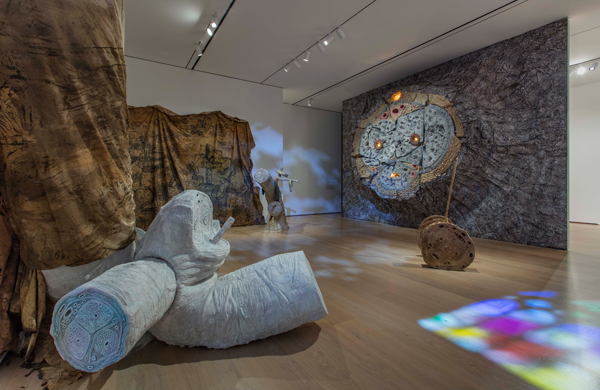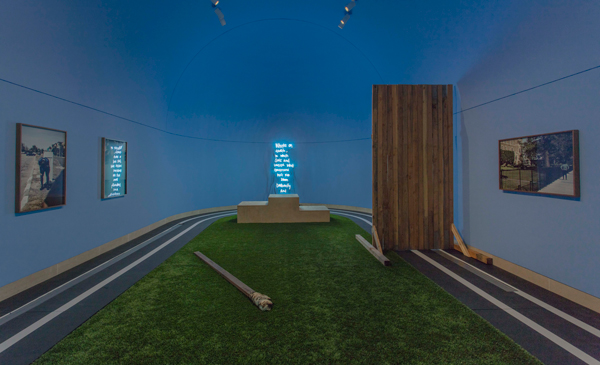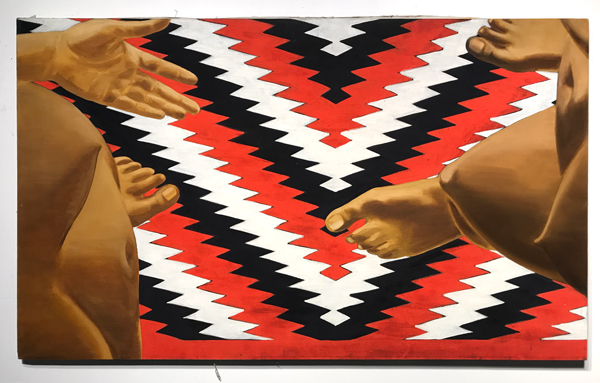“Made in L.A.” has finally hits its stride—this fourth edition feels fresh with discoveries, both of artists you may know and many you may not. It features 32 artists, from emerging ones with promising talent to the exciting re-emergence of an artist who fell from the public eye for several decades—Luchita Hurtado, age 97. In the last two years, Hurtado has had two shows, but her last solo show before that was at the Women’s Building, in 1974. And the work in MiLA is good, very very good—well thought-out, well-crafted, well-presented—and given enough space to breathe in the exhibition design. The following are a few of my own personal favorites.
Two are artists who work in a traditional medium—oil painting—but they play with form and content, Hurtado and Linda Stark. Hurtado’s paintings are mostly from the 1970s, when her kids had grown and she finally had her own studio space. A self-portrait in earthen tones looks back at us from a round mirror held in the artist’s left hand, showing a placid countenance with large almond-shaped eyes. The exhibition features two series of her opus. In one Hurtado looks down a naked body—mostly we see breasts and a rounded belly, sometimes hands and toes—to the geometric patterns of a Native American rug. Large fruits appear in a couple paintings, making the connection between femininity and fecundity. The other series features sky, clouds, and feathers—with a woman’s nude body providing the “landscape” of hills in one of them.

Linda Stark, Self Portrait with Ray, 2017, oil on canvas over panel, 36 x 36 x 2 in., courtesy the artist.
Stark’s paintings are small in this age of gargantuan paintings promoted by mega-galleries (you know who they are), but they have exquisite detail and texture—meticulous build-up of layers and layers of paint. In Brand (2010) the outline of a five-petal flower is pressed into the canvas in red, radiating a sensuous pink aura; in the center is rather a mysterious form that appears like an upper eyelid, with a few hair-like strands dangling from it. The entire surface is ever so slightly crinkled. For anyone who has tried their hand at oil painting, you know that this small work is a tour de force.
In a darkened room near Stark’s paintings are Charles Long’s riffs on the castration complex. It is rather hilarious. After years of seeing tree stumps around his home on Mount Baldy, he was inspired to recreate tubular stumps that appear to have veins and fleshy material in a certain pattern. A huge tarp with drawings of stumps, some cut up in sections and floating in space, covers most of two walls, and an aggressive bas-relief hangs on a third wall. Scattered about are three dimensional stumps made of plaster, aqua resin, paint, rubber, and other materials. Long is having some devilish fun with these critiques of the patriarchy. Take one taller stump from which hang three “melted” cross-sections—a reference to Salvador Dali’s melted watches, and then one even has the “face” of the unfortunate man in Edvard Munch’s The Scream.

Charles Long, Installation view, photo by Brian Forrest.
Carmen Argote was also inspired by what she found around her—in her case, a water-filtration apparatus in a nearby lake. She imagined herself standing atop this large mound and doing an art piece—so she had it rebuilt to size, covered it with cloth, and painted fabric sections while standing on top, letting the color paint drip down from the sides, resulting in Filtration System for a process-based practice (2018). Argote also took the opportunity to think about what it means to be an artist. It’s someone who can enjoy the leisure of walking and observing the world, but also can end up spending far too much time and money fabricating her art—a hand-out brochure discusses the contradictions.
The museum has programmed a lively and varied series of talks, performances, and special events to accompany the show, which ran through Sept. 2. Gordon & Whitmarsh’s Ourchetypes Divination cards, which resemble Tarot cards, are being used in an evening of guided meditation. Flora Wiegmann, dancer and choreographer, is one of the selects this year, and her hypnotic dance piece Reduction Burn (2018) is presented both on monitors in the galleries and live several times through the exhibition’s run.
One performance is ongoing, a durational art piece by artist EJ Hill. As part of his project Excellentia, Mollitia, Victoria (2018), Hill visited every school he has attended in Los Angeles and ran around its perimeter—which must have been quite a jaunt when he had to circumnavigate UCLA! In the museum’s Vault Gallery he has set up a small running “track” built around the perimeter of the space, except that you cannot run (or walk) completely around it. There’s a tall hurdle blocking the path. It’s a trenchant commentary on how barriers continue to be set for African Americans—even when you want to play the game and are willing to play by the rules, the rules get changed on you. On every day the museum is open to the public, the artist himself, in sporty gear and running shoes, stands on one of those three-level medalist podiums at the end of the room. He positions himself on the number one platform, moving every so often as if readying to run the impossible track.

EJ Hill, Installation view, photo by Brian Forrest.
Kudos to the curators for having the guts to include Jade Gordon and Megan Whitmarsh, whose soft-sculptures, installation and videos play on girlishness and girlish fantasies—with a feminist twist. Their work occupies one large room on the second floor. A projection plays on one wall, with the two costumed to play parodies of gender roles, while various sculptural pieces are mounted on the wall and placed on display pedestals. Throughout the room are nine displays of “Ourchetypes,” although I wasn’t sure where one ended and another began.
The duo has a penchant for soft sculpture, and a number of items are made from sewn and stuffed textiles. They range from satin sunglasses lying atop a book with the title All is Possible to a clipboard upon which the names of some illustrious female predecessors are written—Doris Lessing, Corita (I assume that means Sister Corita Kent), Ruth Asawa, and others. In this way history is referenced, as is the mundane (the clipboard, the sunglasses, a plant in a pot), and you could say this is rather a less formal and much funnier version of “The Dinner Party.”

Jade Gordon and Megan Whitmarsh, Installation view, Made in L.A. 2018, June 3-September 2, 2018, Hammer Museum, Los Angeles. Photo: Brian Forrest.
When I went through this room for the third time, it struck me that I felt happy, nearly giddy, at the pastel colors and soft contours around me. Everything felt playful—the large face on the wall, the colorful cubes for seating, the toy-like objects. And then it struck me, two key differences between this show and the previous—the works in this show dare to be delightful, and sometimes even beautiful. There’s also a certain feminine energy that permeates, with 19 women in the list of 32. (The last one, as I recall, had 11 women out of 26 artists.) Perhaps it’s no surprise that the two principal curators are women, Anne Ellegood and Erin Christovale, senior and assistant curator, respectively, on the staff of the Hammer.
And while there’s considerable wit and playfulness throughout the show, there’s also the ballast of seriousness and dedication. Perhaps these dire socio-political times, in which each day brings another hammer blow to the progressive agenda we thought we had won, make artists alive to the moment and to their immediate purpose. Through these 32 artists, “Made in L.A.” has managed to capture the zeitgeist, while providing a little hope in the dark.


